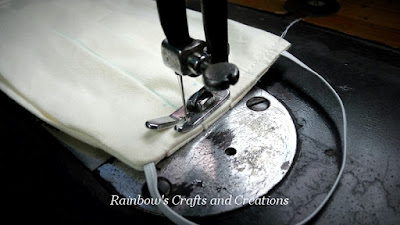The key transmission route of Covid-19 is via droplets that fly out of our mouth when we speak, cough, or sneeze. So, everybody looks for masks since Covid-19 breakout and leads to a short supply in the market, especially the disposable 3-ply surgical masks. Therefore many people start looking for cloth masks or masks covers. Although we know that a cloth mask is not meant to replace the surgical face mask, it is better than none.
I read an article a few days ago, it mentioned that the best cloth masks were constructed of two layers of heavyweight "quilters cotton" with a thicker and tighter weave and had a thread count of at least 180. It
also stated, in other words, if the fabric allowed for a substantial amount of light to shine through, it was probably going to allow tiny viral particles through as well.
Since I have some quilters cotton in hand, I
decide to make some cloth masks for my family members. I don't know the thread count of my cloth but there is not much light that can shine through. I think it should be all right. This is a 3 layers cloth mask cum mask cover, it features an opening at the top, you can insert a piece of liner, or unwoven fabric into the mask for added protection.
A face mask is a precaution that we can take to help slow the spread of Covid-19 but it is not a substitute for physical distancing and other prevention methods.
Materials:
1. A piece of cotton fabric 21cm x 53cm
2. Two pieces of elastic string approximately 17cm
3. A piece of copper wire approximately 12cm
Make a 1.5cm double-fold hem at one of the short edges. So, fold your fabric towards the wrong side by approximately 1.5cm two times. Press the hem and pin it in place. Then, make a 0.5cm double-fold hem at the other short edge. You can either fold the fabric towards the wrong side or right side at this step. Press the hem in place and sew the hem. By referring to the picture on the right-hand side, place your fabric wrong side up, make a partial fold on the fabric by picking up the narrow hem and pull towards the large hem until you form a 31.5cm rectangle, and pin it in place.

Place the fabric right side up. Draw two sets of parallel lines with fabric chalk or water-soluble marking tool as shown in the picture. Start drawing the nine blue lines from left to right and nine pink lines from right to left. The short distance between two parallel lines is 1.4cm. It should be ten pink lines that I need to draw but it seems more difficult for me to explain the measurement here... (it should be one more parallel line at the 3cm space.) Don't worry, it won't be a problem when you make the last pleat. Now, pleat the fabric along sides. Pinch the fabric up so the line with "v" mark is at the top of the fold, fold towards the third line at the right-hand side and pin it. One pleat is finished. Repeat the steps to finish all the six pleats.
You should have six pleats in the same direction. Sew the pleats in place. You will find that the pleats on the partial folded part relatively thick.
Fold the fabric in half with the right sides together, sew the edges on either side where I mark with the blue lines. The part with the opening will be the top of the mask.
Sandwich the elastic string into the side opening and pin both ends at the bottom and the top of the mask respectively. Sew a 0.5cm seam to close the opening. Repeat the step to the other side opening.
Turn the mask right side out and topstitch a 0.5cm seam at both short edges. If you don't need a nose wire for your mask, a simple mask is done at this step. If you need a nose wire for more comfortable and secure, please go to the next step.
The picture on the left-hand side is a nose wire, remember to bend over the sharp ends before you insert it into the mask layers. After that, insert the wire to the very top of the front layer (the double layer) of the mask. Sew the 3 sides as shown in the picture to keep the wire in place. The room for the wire should be slightly bigger than your wire.
Finally, I hope all people around the world are keeping well during this extremely challenging time. Together we can win the war against Covid-19!!













